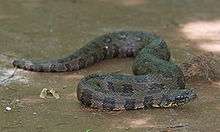Brown water snake
| Brown water snake | |
|---|---|
 | |
| Nerodia taxispilota in West Palm Beach, Florida | |
| Scientific classification | |
| Kingdom: | Animalia |
| Phylum: | Chordata |
| Subphylum: | Vertebrata |
| Class: | Reptilia |
| Order: | Squamata |
| Suborder: | Serpentes |
| Family: | Colubridae |
| Subfamily: | Natricinae |
| Genus: | Nerodia |
| Species: | N. taxispilota |
| Binomial name | |
| Nerodia taxispilota (Holbrook, 1842) | |
| Synonyms | |
_Central_Florida.jpg)
The brown water snake (Nerodia taxispilota) is a large species of nonvenomous natricine snake endemic to the southeastern United States.
Lycodonomorphus rufulus is sometimes also called the brown water snake, but L. rufulus is found in South Africa.
Common Names
Brown water snake, water-pilot,[1] aspic, false moccasin, great water snake, pied water snake, southern water snake, water rattle, water rattler.[2]
Geographic Range
Nerodia taxispilota is found in lower coastal regions from southeastern Virginia, through North Carolina, South Carolina, and Georgia, to northern and western Florida (Gulf Coast), then west through Missouri, Alabama and Mississippi, to Louisiana, normally from sea level to 500 ft. (150 m) elevation.[2]
Description
The brown water snake is very heavy-bodied, and its neck is distinctly narrower than its head. Dorsally it is brown or rusty brown with a row of about 25 black or dark brown square blotches down its back. Smaller similar blotches alternate on the sides. Ventrally it is yellow heavily marked with black or dark brown.[3] Dorsal scales are in 27-33 rows (more than any other North American water snake), and it has 2-4 anterior temporals (usually 1 in others).[4] Adults measure 30-60 in. (76–152 cm) in total length; record 69 in. (175 cm).[5]
Habitat
Nerodia taxispilota is found in swamps and streams and is often mistaken for a venomous snake.
Reproduction
Nerodia taxispilota is ovoviviparous. Mating takes place in the spring on land or on tree branches. On average adult females are larger than adult males. The young are born alive, usually in August, in broods of 14-58, more commonly 30-40. The newborns are 7-10¾ in. (18–27 cm) long, with males longer than females, opposite of adults.[2]
Original publication
- Holbrook, J.E. 1842. North American Herpetology; or, a Description of the Reptiles Inhabiting the United States, Vol. IV. J. Dobson. Philadelphia. 138 pp. (Tropidonotus taxispilotus, pp. 35–36 & Plate VIII [opposite p. 35].)
References
- ↑ Stejneger, L., and T. Barbour 1917. A Check List of North American Amphibians and Reptiles. Harvard University Press. Cambridge, Massachusetts. 125 pp. (Natrix taxispilota, p. 97.)
- 1 2 3 Wright, A.H., and A.A. Wright. 1957. Handbook of Snakes of the United States and Canada. Comstock. Ithaca and London. 1,105 pp. (in 2 volumes) (Natrix taxispilota, pp. 544-547, Figure 162, Map 41.)
- ↑ Schmidt, K.P., and D.D. Davis. 1941. Field Book of Snakes of the United States and Canada. G.P. Putnam's Sons. New York. 365 pp. (Natrix taxispilota, pp. 213-215 + Plate 23, Center, on p. 343.)
- ↑ Smith, H.M., and E.D. Brodie, Jr. 1982. Reptiles of North America: A Guide to Field Identification. Golden Press. New York. 240 pp. ISBN 0-307-13666-3 (paperback) (Nerodia taxispilota, pp. 154-155.)
- ↑ Conant, Roger. 1975. A Field Guide to Reptiles and Amphibians of Eastern and Central North America, Second Edition. Houghton Mifflin. Boston. 429 pp. ISBN 0-395-19979-4 (hardcover), ISBN 0-395-19977-8 (paperback) (Natrix taxispilota, p. 141 + Plate 21 + Map 107.)
Further reading
- Conant, R., and W. Bridges. 1939. What Snake Is That? A Field Guide to the Snakes of the United States East of the Rocky Mountains. D. Appleton-Century. New York and London. Frontispiece map + viii + 163 pp. + Plates A-C, 1-32.) (Natrix taxispilota, pp. 106-107 + Plate 20, Figure 58.)
- Morris, P.A. 1948. Boy's Book of Snakes: How to Recognize and Understand Them. A volume of the Humanizing Science Series, edited by Jacques Cattell. Ronald Press. New York. viii + 185 pp. ("The Brown Water Snake", pp. 84-85, 180.)
